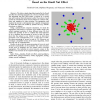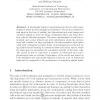91 search results - page 5 / 19 » Spatial Interception for Mobile Robots |
IROS
2009
IEEE
14 years 4 months ago
2009
IEEE
— We study a simple algorithm inspired by the Brazil nut effect for achieving segregation in a swarm of mobile robots. The algorithm lets each robot mimic a particle of a certain...
MIRRORBOT
2005
Springer
14 years 3 months ago
2005
Springer
Abstract. A biologically inspired computational model of rodent representation–based (locale) navigation is presented. The model combines visual input in the form of realistic tw...
ICRA
2002
IEEE
14 years 2 months ago
2002
IEEE
— This paper describes decentralized control laws for the coordination of multiple vehicles performing spatially distributed tasks. The control laws are based on a gradient desce...
ICRA
2007
IEEE
14 years 4 months ago
2007
IEEE
— We introduce an algorithm which detects and traces a specified level set of a scalar field (a contour) on a plane. A network of static sensor nodes with limited communication...
ICRA
1993
IEEE
14 years 1 months ago
1993
IEEE
An issue central to the navigation problem is memory. Traditional systems build symbolic maps of the world for navigational reference. Reactive methods, in contrast, eliminate or m...


